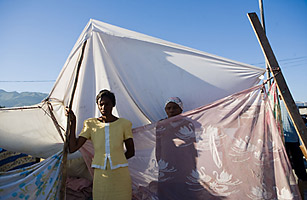
Families live in a tent city in Carrefour, Haiti, three miles west of Port-au-Prince
A dozen young men jostled one another waiting in line on Jan. 24 for food and water in Cité Soleil, one of Haiti's poorest neighborhoods. One wore an Obama campaign T-shirt, and when asked about it, he and his comrades grinned and chanted, "Obama!" But when asked if they would stay in Port-au-Prince and help rebuild the devastated city as the Obama Administration is encouraging Haitians to do, they all shook their heads. "As Obama said, all Haitians are Americans, and all Americans are Haitians," said Bertrand Aboite, 31. The U.S. President never actually said this. He did pledge that Haitians wouldn't be "forgotten" or "forsaken," but many Haitians appear to have taken away another message.
"I want to go to Cap-Haitien as soon as possible and take a boat to Miami," said Aboite, referring to the port city on Haiti's north coast facing the U.S. "Me too, me too," piped up Sello James, 15, who lost an aunt and a cousin in the earthquake. A chorus of agreement followed as the men and boys lapsed into dreams of Miami and plots involving stolen boats and much rowing.
Though extreme, their desire to flee Port-au-Prince is shared by many in this city that had accounted for about a third of Haiti's population before the disaster — some 3 million people. No one knows how many have died — though the estimates go as high as 150,000. But as aftershocks continue to rattle the capital, many more of its skittish denizens are fleeing town. Thousands have piled onto ferries to Les Cayes in the south and Cap-Haitien, the old northern capital and a favorite launching ground for those willing to risk a sea crossing of more than 400 miles in the hopes of attaining the American dream. Others are imposing themselves on rural relatives for refuge or have bought their way into the Dominican Republic. What is clear, though, is that Port-au-Prince is a shattered metropolis, incapable of sustaining the 3 million who called it home.
Haiti's rich and middle classes have the easiest tickets out. Many upper-class Haitians have country homes in the Dominican Republic and already possess multiple-entry visas to cross into the country on the other side of the island of Hispaniola. For new applicants, the line is long and the cost is steep — to the tune of a few hundred U.S. dollars (Haitians have an annual per capita GDP of $1,300). Getting in illegally is cheaper: hire a coyote and hike the hills or bribe your way through the nine police checkpoints that have magically cropped up in the 11 days since I last drove between Santo Domingo and Haiti. An untold number of Haitians have already taken this route, swelling Santo Domingo's Creole community noticeably.
But Haitians can cross the border and still be out of luck — if they don't have money. Amelia Bernard, 40, lost six family members when her Port-au-Prince house collapsed. She and five other kin were fortunate: they were evacuated with an injured relative to a hospital in Jimani, a Dominican town on the border of Haiti. But, lacking funds, they are in limbo: stuck with no home or prospects in Haiti but no way forward deeper into the Dominican Republic because they can't afford visas. "We are waiting, waiting to see where life leads us," Bernard says.
For those simply wanting out of the misery of Port-au-Prince, the Haitian government is building a tent city in the exurb of Croix des Bouquets. To that end, President René Préval asked the international community on Monday for 200,000 family tents to be rushed to Haiti as soon as possible. The government wants people settled well ahead of the rainy season, which is due to start in just over a month. Ad hoc tent cities with badly dug latrines have a long history of leading to deadly cholera epidemics when rain mixes bad water with good.
But aside from fleeing the country or setting up temporary camp, the solution most experts are hoping for is that Haitians move in long-term with their relatives in the countryside. One of Haiti's problems, developmentally speaking, has always been the urban focus of its population; nearly half, 47%, of the population lives in the cities. Centuries ago, when Toussaint Louverture won independence for Haiti, the population of former plantation slaves turned away from agriculture in disgust. If more Haitians farmed, the country would be more self-sufficient and a network of towns would strengthen the country's internal markets. "Every economy needs diversity, and Haiti will rebuild stronger, I think, with many towns and cities instead of a single metropolis," says Wally Amundson, the Latin America director for the Adventist Disaster and Relief Agency, which has been operating in Haiti for more than 30 years.
After he drops his sister off in Santo Domingo, Theophile Amos, 25, plans on staying with family in Môle Saint-Nicolas. His Port-au-Prince home and the factory he worked in were both destroyed; he also lost a sister and his parents. Amos doesn't know when he'll ever finish his journalism degree, but he thinks he'll have a better shot at finding work in the northwestern Haitian town. "Port-au-Prince has too many memories, too many ghosts," he says, adding that in Môle Saint-Nicolas, "I hope to start again fresh."
Read more in the new TIME book Earthquake Haiti: Tragedy and Hope and support TIME's Haiti relief efforts.